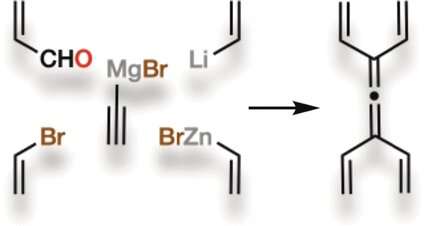Strained, symmetric, and new: Tetravinylallene, a small but powerful molecule, has been synthesized for the first time

Many natural compounds used in medicine have complex molecular architectures that are difficult to recreate in the lab. Help could come from a small hydrocarbon molecule, called tetravinylallene, which has been synthesized for the first time by Australian scientists. As detailed in the journal Angewandte Chemie, tetravinylallene can be used to construct complex molecular frameworks more quickly and with less environmental impact than by using established methods.
Tetravinylallene has a remarkably unsaturated molecular structure. Binding of two carbon atoms to each other can be achieved with three types of bonds; either single, double, or triple bonds. Bonds other than single bonds are called "unsaturated" (for example, unsaturated fatty acids contain a mixture of double and single bonds). How these bonds are arranged in a molecule determines its reactivity. Molecules are less reactive and more stable when double bonds alternate with single bonds, but two double bonds in a row give a strained electron configuration, which makes the molecule reactive.
Graduate student Cecile Elgindy, working with Professor Michael S. Sherburn at the Australian National University, Canberra, synthesized the highly unsaturated compound tetravinylallene for the first time. The molecule possesses two adjacent double bonds in its center, both of which are flanked by two entities composed of a single bond followed by a double bond.
Tetravinylallene is electronically strained and it is also symmetric, which would allow chemists to perform multiple reactions in one step. That would make it possible to construct new molecules with complex architectures in fewer steps and with fewer chemicals. Analogues of tetravinylallene do already exist, but those molecules are smaller and less symmetric.
The researchers admit that the synthesis of tetravinylallene was challenging; however, a five-step procedure involving sequential attachment of four small molecules to each other was successful. The scientists also prepared derivatives of tetravinylallene with a slightly altered structure but unchanged bond system.
The researchers made use of tetravinylallene in a proof-of concept synthesis by transforming it into a compound with a complex steroidal architecture. In that procedure, only one reaction partner was necessary and all reactions were controlled simply by varying conditions such as the reaction temperature and solvent.
The study positions tetravinylallene as an intriguing and potent new chemical with practical utility in the synthesis of natural products and drugs. It joins the group of existing small hydrocarbons packed with double bonds but excels because of its symmetry. Tetravinylallene might inspire synthetic chemists who are on the lookout for new methods to synthesize natural products and drugs, or who wish to push the frontiers of basic research.
More information: Cecile Elgindy et al. Tetravinylallene, Angewandte Chemie International Edition (2019). DOI: 10.1002/anie.201908496
Journal information: Angewandte Chemie International Edition , Angewandte Chemie
Provided by Wiley



















